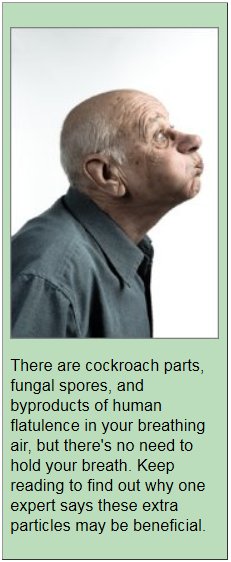|
What Exactly is in Every Breath You Take? |
|
You take an average of 24,000 breaths every day. This amounts to about 2 gallons of air taken into your body every minute, and almost 3,000 gallons every day.
In fact, air is made up of:
Just what types of contaminants are released into the air? Cancer-causing formaldehyde (to the tune of 250,000 tons a year), benzene (about 375,000 tons a year) and ammonia from agricultural operations (2 million tons year), to name a few. But while you may expect some of these environmental pollutants to be lurking in the air you breathe, there are other, quite shocking, things -- from underground, outer space and more -- in there as well. Your Air Travels Around the World Molecules in air ricochet off one another at hundreds of miles per hour. In just weeks, any given volume of air molecules will have traveled around the world. In a few years, those same molecules will be evenly spread throughout the entire lower atmosphere of the planet, according to DISCOVER Magazine. What does this mean to you? In short, that any and every particle that's released into the air will eventually make it to your neck of the woods, and very likely into your lungs.
Take, for instance, cosmic dust. This once belonged to huge space rocks that, fortunately, were broken down by the Earth's atmosphere. Still, the particles trickle down and move through the air, and we all reportedly inhale three particles from a meteoroid every year, according to DISCOVER. The Air in Your Home While your outdoor air may be ripe with chemicals, your indoor air is an entirely different animal. DISCOVER has pinpointed the numerous sundries in your home and office environments. Consider that in your home you're breathing in: Chlorine gas from your cleaning products Pieces of cockroaches and other bugs The average adult takes in
And if you've ever experienced flooding in your home, indoor mold is most assuredly also in your air. Is all of this random "stuff' in your air harmful? Quite the contrary. The low levels of bacteria and other microbes in your air may help to boost your immune system, according to Eoin Brodie, a microbiologist at the Lawrence Berkeley National Laboratory in California. "It may actually be protecting us," he says in DISCOVER. Of course, the idea of breathing in cockroach bits is not pleasant. Household dust alone contains not only insect parts (including ant heads and more) but also:
Of course, it's impossible to remove EVERY particle from your air, and, as Brodie pointed out, you wouldn't want to. Simply using commonsense in regard to the toxins (pesticides, cleaning products, etc.) you release into your home, and dusting your home regularly to keep it clean, will go a long way toward keeping your and your family's indoor air safe and sound. |


 While you may typically think of "air" as oxygen, this vital gas
makes up only a small portion of the gaseous mix you inhale.
While you may typically think of "air" as oxygen, this vital gas
makes up only a small portion of the gaseous mix you inhale. Certain pollutants ARE exempt from this rotating process
because they're broken down before they travel too far, yet
many chemicals do travel thousands upon thousands of
miles.
Certain pollutants ARE exempt from this rotating process
because they're broken down before they travel too far, yet
many chemicals do travel thousands upon thousands of
miles.


